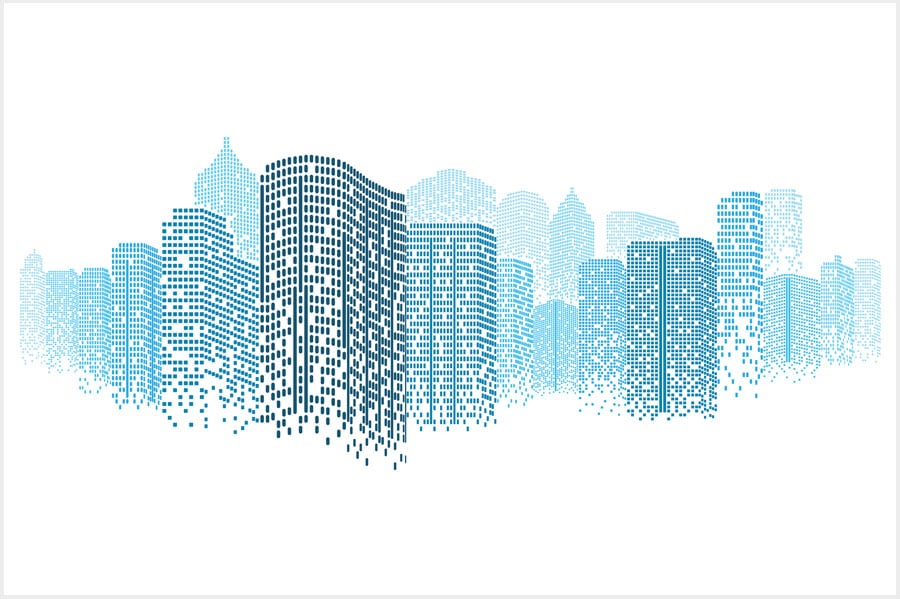Imagine that while we manufactured a product – or in the case of a building, while we constructed it – and once it had been completed, we simultaneously had an exact digital replica of that asset that we could analyze to ensure it would work as we wanted it to. How good would that be?
This is not a figment of the mind of a technician in Silicon Valley – it is the concept of a digital twin. It is already a reality in sectors such as manufacturing and is evolving more widely as fast as developing technology will allow.
According to the Gemini Principles, developed by the Centre for Digital Built Britain (CDBB), a digital twin is “a realistic digital representation of assets, processes or systems in the built or natural environment.”
What is a digital twin?
Put simply, a digital twin effectively enables an early assessment of a product’s viability and can help improve understanding and collaboration between stakeholders – suppliers, designers, etc. – as it is being delivered.
The CDBB says that what distinguishes a digital twin from any other digital model is its connection to the physical twin. Based on data from the physical asset or system, a digital twin “unlocks value principally by supporting improved decision-making, which creates the opportunity for positive feedback into the physical twin.”
Some suggest digital twins began with NASA, with the US space agency looking to create identical scenarios that would help astronauts cope with the rigors of space travel.
While such practicalities are obvious when human beings enter the potentially lethal environment of deep space, according to technology giant IBM, data is key to a digital twin’s success.
Informed with data, IBM says the virtual model can be used to “run simulations, study performance issues and generate possible improvements, all with the goal of generating valuable insights which can then be applied back to the original physical object.”
Taking this to its logical conclusion, many believe digital twins in the construction industry hold enormous potential. For Ibrahim Atta-Apau, a director at consultancy Atkins, the potential for transforming construction can already be seen in the manufacturing sector, “which has embraced the use of data and technology to revolutionise the production process.”
Game changer
Digital twins, he says, “clearly represent a potential game changer as we continue to grapple with productivity challenges and a patchy record in project delivery, but we’ve some way to go before we become a shining example for other industries.”
It took time for people to accept that BIM wasn’t just a piece of software, he says, but a whole methodology and approach to the entire infrastructure life cycle that demands a change in behaviors. “Digital twins are no different,” he says, while the level of collaboration across a supply chain that shares data and information seamlessly is something that offers huge potential.
According to SNCLavelin (SNCL), the digital twin promises more effective asset design, project execution and asset operations by dynamically integrating data and information throughout an asset’s life cycle to achieve short- and long-term efficiency and productivity gains.
Says SNCL: “It’s a data resource that can improve the design of a new asset or understanding of existing asset condition, to verify the as-built situation, run ‘what if’ simulations and scenarios or provide a digital snapshot for future works. This has the potential to vastly reduce errors and discontinuities present in more traditional methods of information management.”
Software engineers develop digital twins using virtual modeling tools and creating the means to collect and analyze the relevant data. Digital twins can be used across a number of sectors, from energy to hospitality and even retail, using data-enriched models to improve efficiencies or test theories about certain behaviors, human or otherwise.
Optimizing modern methods of construction
Some believe the use of digital twins in construction can speed up the use of modern methods such as modular and pre-fabrication. Contractor Lendlease argues that digital twins can bring sustainability in line with a project’s design goals.
Digital twins, the firm says, can reveal a scheme’s likely carbon footprint and energy efficiency before a spade hits the ground. “In addition, the technology means that the various pieces of a structure can be produced in an off-site factory and then assembled on site; thus, buildings can be not only easily assembled but also disassembled and reused to support a circular economy.”
Lendlease said a digital twin it had designed had been important in testing the viability of building a 29-story development in Melbourne, Australia, made from sustainable timber.
The contractor said timber hadn’t been used on a building this high before, and the “inclusion of the project’s processes and materials in the digital twin identified options and produced a more granular understanding of process and cost for developers.”
Although it’s still early in the design process, Lendlease says the digital twin for the towers has already provided insight on how to actively tighten the project timeline and reduce costs.
What of the future?
So where can digital twin technology go next? The CDBB envisions a time when there will be a “national digital twin,” where any number of digital twins are combined into a sort of ecosystem, crossing a range of sectors and connected via securely shared data.
Such an ecosystem would never be finished, the CDBB says; instead, it would be added to as infrastructure and other sectors grew.
In essence, it would be an ever-growing, ever-evolving digital mirror of the reality around us.












